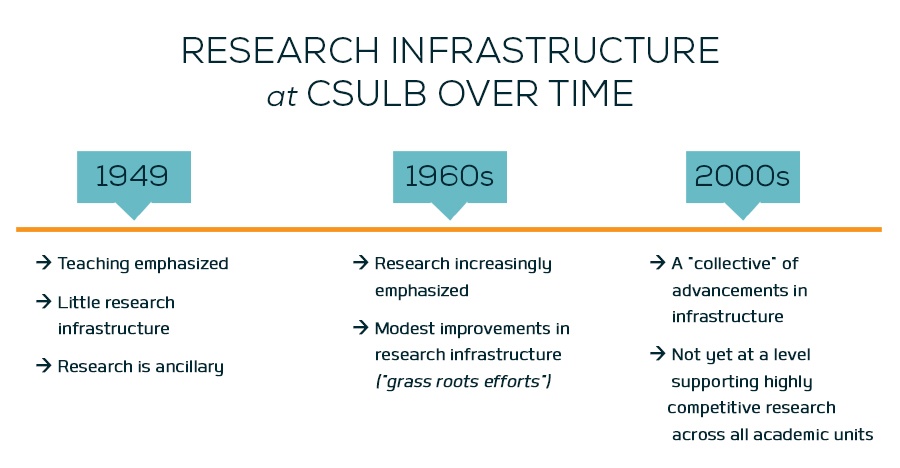A History of BUILD - The First Five Years
Why BUILD for CSULB?
In the first two decades of its existence, CSULB emphasized teaching and provided little infrastructure devoted to research. While selected faculty-initiated research was done, it was an activity ancillary to full-time teaching duties.
Since the late 1960s, however, research progressively increased in importance in the faculty assignment (e.g., it became part of tenure requirements). With this came modest improvements in infrastructure to support research, although these were largely uncoordinated given limited administrative oversight and leadership.
CSULB's history can be characterized as a "grass-roots effort" to improve the research culture and infrastructure, occurring largely within departmental and college levels. Today, the campus research environment benefits from this "collective" of advancements in infrastructure, with some notable successes in biomedical sciences research. Yet, the campus has not advanced to the degree necessary to adequately support highly competitive research consistently across all relevant academic units.

A major developmental barrier for CSULB has been the historical lack of a coherent institutional infrastructure and strategic plan that facilitates research. The campus has had almost no integration of its research infrastructure across units, very limited resources sharing or efforts to expand access, poor collaboration across units, and a lack of consistency in the respective colleges' "research cultures" and administrative support for research.
The BUILD grant provided a framework and funding for improving the research culture on campus and supporting both faculty and student researchers in their endeavors.
The Barriers to Research on Campus
To be competitive and be accepted into doctoral programs, students need to have undergraduate research experience. In order for there to be opportunities to gain this experience, faculty need to have time and funding to devote to research.
CSU institutions traditionally mandate a heavy teaching load. The principal mechanism by which faculty may reduce teaching load is through purchasing "assigned time" to carry out research. Selected intramural support mechanisms are available but they are limited in number and typically provide 25% (=1 course) release in a given semester per year. For faculty to have the time necessary to maintain a robust research effort, they must consistently find extramural grant funding devoted to purchasing assigned time.
Furthermore, it is critical that new faculty members obtain grants early in their tenure, and then subsequently remain funded to avoid teaching full-time which will impact their research productivity. The university partly addresses this issue by offering assigned time (25%) to new faculty during their first three years, and some colleges and departments match this to reach 50%, providing new faculty an opportunity to raise funds for assigned time and research.
Teaching load of CSULB faculty represents a barrier to equal competition (e.g., vs. faculty at other university systems) in developing robust, competitively-funded research programs. Therefore, if CSULB is to expand its research and provide greater capacity and quality for student research training for doctoral programs, the institutional time-balance of faculty needs to be addressed.
Research Infrastructure Challenges: 2015
- Limited adminstrative oversight and leadership historically
- Siloed structure with limited strategic planning and coordination of resources and assets
- Insufficient communication across units and wide disparities in support for research
- Time dedicated for research and pursuing funding opportunities
- Lack of faculty diversity and limited opportunities to improve mentorship skills





